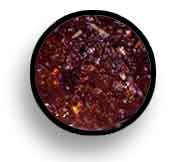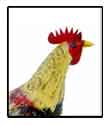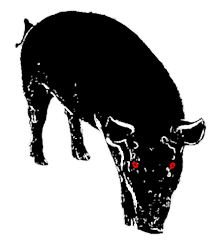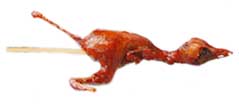Philippine cuisine is a
smorgasbord of tastes and influences, with its Malay roots, centuries
of Hispanization of its taste buds, strong Chinese influences, spiced
up by dashes of International culinary additives, further tweaked by
touches of regional cuisine. Every province contributes a signature
dish or two to the national palate and the diversity of indigenous cultures
further adds spice and mystery to the feasting table offerings.
 |
|
Much of the
urban-suburban restaurant cuisine should be familiar or easily demystified
with a modicum of translation. Street-cart pedestrian cuisine and excursions
to the hinterlands, however, will inevitably expose the traveler to
unfamiliar culinary offerings: meaty offerings that could have been
barking yesterday, formalin-extended curbside calamares, delectable dishes that suffered slow and brutal deaths,
cuisine of dangling anatomical origins that is purported to drive one
to new libidinous heights, bloody dishes that will make Jehovah's witnesses
squirm and skeddadle, and the usual discards of entrails, heads and feet reinvented
into masa affordable pulutan dishes.
Culinary
Anarchy
There are no health-and-nutrition guidelines to Philippine street-cart
and rural cuisine. In the urban-suburban upscaling dining places, there
may be occasional offerings and come-on attempts with the healthy, organic,
nutritional, low salt, low fat,
olive-oiled dishes. But in most places where the masa ventures,
in food courts, street cart cuisine and sidewalk dining, almost certainly
in the hinterlands, Philippine culinary offerings are devoid of health
concerns – where cholesterol, saturated fat and trans-fat are
alien and absurd issues, where used cooking oil is saved for reuse or
poured over rice for taste, where no meat dish is considered palatable
without a slab of flavoring fat, where salt in its many forms - patis
(fish sauce), bagoong (shrimp paste), toyo (soy sauce) - is used in
amounts excessive and threatening to the cardiac and hypertensive, and
where Vetsin (MSG, monosodium glutamate) is a favorite and ubiquitous
condiment.
Also, Filipinos have an amused
penchant in watching travelers tasting, delighting and savoring dishes,
unaware of their yucky beginnings. The balut, the official dare-food,
is at least undisguised in its yuckiness, as are the other pulutan favorites
like Adidas, IUD and day-old-chick. But many Filipino yucky-but-yummy
dishes, including some "aphrodisiac" (UpYourDickSiac) dishes,
are cooked, prepared and disguised into seeming palatability by sauce,
garnish, and presentation.
Lastly, you of intrepid souls,
no matter your hunger or your adventuresomeness, don't. . . don't be
tempted by those roadside carinderias, counters lined with aluminum
pots filled with native dishes. Although some may be safe, many serve
unrefrigerated once- or twice-reheated foodstuff, fine for the natives'
tolerant guts, but always risky for the traveler.
So, even if you're
one of those bungee-jumping, worm-eating, snail-sucking, bone-marrow-thumping,
i'll-try-anything-once kind of traveler, it won't hurt to know the lowdown
on some of the more common yucky-but-yummy Filipino dishes.
Bon appétit
!
 Dinuguan Dinuguan
Pork Blood Stew
Easy to recognize, it is a thick black stew. Pork blood,
the freshest possible, is its defining ingredient. Prepared in a
variety of ways, it is a delicious dish, if one can get beyond its
bloody origins. It is a dish that might delight Dracula as a midnight
snack alternative when he tries to wean himself from his favorite
ritual neck dish addiction. As a meal, consumed with ample amounts
of rice; as a snack, with 'puto,' the Filipino rice cake. |
 Pinikpikan Pinikpikan
A
popular Cordillera chicken dish. The preparation involves
mercilessly battering the chicken with a stick as it squawks to
its slow death. The brutal process attempts to coagulate the blood
onto the wings, neck and meat to achieve a bloody flavorful chicken
dish. Etag, cured meat, aged underground,
is an optional ingredient that further augments the flavor. Alas,
it is an inhumane process that achieves the delectable end and one
that violates that the Philippine
Animal Welfare Act of 1998. (See also: The
Bontoc ritual preparation of Pinikpikan) |
 Asocena Asocena
A portmanteau of "aso" (dog)
and 'cena' (dinner meal). .
In the Philippines, especially in the rural areas, the dog is more
often food than pet. Stray dogs are common victims of pulutan-seeking
(side dish) predators for their alcohol-fueled gatherings. The killing
is merciful, unlike the pinikpikan chicken, accomplished through
a neck snare and a head whomp. Preparation varies according to regional
preferences; some recipes capably hide the gamey and pungent of
it. Although considered a proletarian dish, it is a learned taste
appreciated by many in the middle class and in some provinces, finds
it way on the feasting tables.
http://en.wikipedia.org/wiki/Asocena |
 Sisig Sisig
Another
pork dish, the defining ingredient is the pig's head, in particular,
the ears, nose and cheeks, chopped into a cartilaginous mix.
Likely of Kapampangan origin, from unused pig's heads purchased
cheaply from the Clark Air Base commissaries of olde. Made from
parts of the pig's head (chopped ears, nose and cheeks) and variations
that may include brain, chicken liver or chopped mixture of innards,
seasoned with kalamansi and chili peppers. A favorite "pulutan"
dish and a chewing, cracking and cartilaginous culinary experience.
|
 |
Tortang utak
Pig's
brain omelet
Cheeks, lips, nose, ears, bile, intestine, blood, feet. . . nothing
goes to waste. Brain? . . . yeah. There's pig's brain omelet. The
brain is boiled, then sliced or mashed, with onions and garlic,
blended with eggs, and pan-fried. It has a quaint and indefinable
taste, yummy and easy to like not knowing what it is, yucky and
easy to hate when you find out what it is. |
Soup
Number Five
Soup
No. 5, Soup # 5
In local parlance, it is called. . .
. . . ta dah. . .
Bat and Ball !
It is made from bull's testicles and/or penis,
a dish high up there in the Filipino's grail of the ultimate aphrodisiac
food. The bat and balls. . . um. . .penis and testicles are cleansed
and chopped up and mixed with the generic soup ingredients and
condiments – ginger, vegetables, chicken or pork, salt and
pepper – to make the quintessence Filipino aphrodisiac culinary
offering. Or, in the Pinoy's penchant for creative word-making,
allow me to offer one – the UpYourDickSiac
soup. Serve hot.
Bon appetit !
|
 IUD IUD
Isaw
Barbecued
or grilled skewered chicken intestines that derives its name from
a gross similarity to the IUD – intra-uterine device. Also
popularly known as "isaw." Popular and affordable street-cart
snack or pulutan. |
Papaitan
An intestine dish cooked
in bile
Etymology: "pait" means
bitter.
It's an intestine and
skin dish, usually goat, cooked in bile giving the dish its defining
bitter taste. Some prepare the dish to include the partially
digested intestinal contents, more proximal than distal. Other innard
parts are often thrown in: tripe, liver, kidneys, pancreas with
the usual spices, and optional bagoong for the taste and to temper
the bitterness. |
 Adidas Adidas
Chicken
feet
Yes, of course, named in honor of the
world class footwear. Why not Nike? Doubt that would have worked.
I think the choice had to do with the vowel sounds, the familiar
hard delivery of rural vowel phonetics. The claws and toes of the
chicken-tootsies are trimmed, the tough skin peeled off, marinated
and grilled to a skewered chewable nibbling delight. It
is a popular proletarian street-cart tide-over-your-hunger snack
or alcohol pulutan that is also finding itself in menus of
dives and low-end restaurants menus. |
 Day-old
chicks Day-old
chicks
Day-old male chick
rejects become butt-skewered batter-fried sidewalk and street cart
offerings. Best dipped in vinegar or hot sauce. With adidas, IUD,
and balut, joins the masa's list of finger-licking-good pulutan
favorites. |
Bahay guya
Cow abortus |
Itlogan
Chicken
uterus filled with early stages of eggs. |
• |
| Also read:
The ABCDE of Philippine Cuisine |
by
Godofredo Umali Stuart |
|









